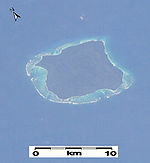- North Sentinel Island
-
North Sentinel Island Geography Coordinates 11°33′N 92°14′E / 11.55°N 92.233°ECoordinates: 11°33′N 92°14′E / 11.55°N 92.233°E Archipelago Andaman Islands[1] Area 72 km2 (27.8 sq mi) Country Union Territory Andaman and Nicobar Islands Demographics Population 250 to 300[2] (as of 2005) Ethnic groups Sentinelese[1]  Outline map of the Andaman Islands, with the location of North Sentinel Island highlighted (in red).
Outline map of the Andaman Islands, with the location of North Sentinel Island highlighted (in red).
North Sentinel Island is one of the Andaman Islands in the Bay of Bengal. It lies to the west of the southern part of South Andaman Island, and has an area of 72 km².[1] Most of the island is forested.[3] Because it is small, located away from the main settlements on Great Andaman, surrounded by coral reefs, and lacks natural harbors, it was never settled by Europeans.[4]
A group of indigenous people, the Sentinelese, live on North Sentinel Island. They speak the Sentinelese language[5] and their present numbers are estimated to be anywhere between 50 and 400 individuals. They reject any contact with other people, and are among the last people to remain virtually untouched by modern civilization.[4]
 Detail of 2003 NASA image (from the International Space Station) of North Sentinel Island; the island's protective fringe of coral reefs can be seen clearly. Note this image pre-dates the 2004 tsunami, which caused the uplift and exposure of much of the reef.
Detail of 2003 NASA image (from the International Space Station) of North Sentinel Island; the island's protective fringe of coral reefs can be seen clearly. Note this image pre-dates the 2004 tsunami, which caused the uplift and exposure of much of the reef.
Contents
History
The earliest known mention of the Sentinelese was made by the British surveyor John Ritchie in 1771. An expedition led by Maurice Vidal Portman, a government administrator who hoped to research the natives and their customs, accomplished the first known successful landing on North Sentinel Island in 1880. The group found a network of pathways and several small, abandoned villages. After several days, six Sentinelese were captured and taken to Port Blair. They soon became sick, however, and two of them died. The other four were returned to the island.[4][1]
The second recorded landing was made on August 27, 1883 after the eruption of Krakatoa was mistaken for gunfire and interpreted as the distress signal of a ship. A search party landed on the island and left gifts before returning to Port Blair.[1]
Indian exploratory parties under orders to establish friendly relations with the Sentinelese made brief landings on the island every few years between 1967 and 1997.[1] In 1975, Leopold III of Belgium, on a tour of the Andamans, was brought by local dignitaries for an overnight cruise to the waters off North Sentinel Island.[4] In the 1980s and early 1990s many Sentinelese were killed in skirmishes with armed salvage operators who visited the island after a shipwreck.[6]
Parts of the island were tilted by the December 2004 earthquake, sinking some of the surrounding coral reefs and raising others. The survival of the Sentinelese was confirmed when, three days after the event, an Indian government helicopter observed several of them, who shot arrows and threw stones at the hovering aircraft with the apparent intent of repelling it.[7][1] The coastline of the island has changed completely, and although the fishing grounds of the Sentinelese were disturbed, they appear to have adapted to the island's current conditions.[8]
The government of the Andaman and Nicobar Islands has recently stated that they have no intention to interfere with the lifestyle or habitat of the Sentinelese and are not interested in pursuing any further contact with them.[2]
Political status
Officially, the island has been administered by India as part of the Andaman and Nicobar Islands Union Territory since 1947.[9] However, because there has never been any treaty with the people of the island, nor any record of a physical occupation whereby the people of the island have conceded sovereignty, the island exists in a curious state of limbo under established international law and can be seen as a sovereign entity under Indian protection. It is, therefore, one of the de facto autonomous regions of India.
References
- ^ a b c d e f g George Weber. "The Andamanese - Chapter 8: The Tribes". pp. part 6. The Sentineli. http://www.andaman.org/BOOK/chapter8/text8.htm#sentineli. Retrieved 2007-05-03.
- ^ a b Subir Bhaumik. "Extinction threat for Andaman natives" March 5, 2005.
- ^ George Weber. "The Andamanese - Chapter 2: They Call it Home" Retrieved October 12, 2011
- ^ a b c d Adam Goodheart. "The Last Island of the Savages". American Scholar. Autumn 2000.
- ^ Christopher Moseley, "Encyclopedia of the world's endangered languages," p. 289, 342 (Routledge, 2007) ISBN 9780700711970, found at [1]. Accessed October 7, 2009.
- ^ Peter Foster. "Stone age tribe kills fishermen who strayed on to island". February 8, 2006.
- ^ Buncombe, Andrew (February 6, 2010). "With one last breath, a people and language are gone". The New Zealand Herald. The Independent. http://www.nzherald.co.nz/world/news/article.cfm?c_id=2&objectid=10624531. Retrieved November 1, 2011.
- ^ "The 2004 Indian Ocean Earthquake and Tsunami" Retrieved October 8, 2011
- ^ George Weber. "The Andamanese - Chapter 1: Contact" Retrieved October 8, 2011.
See also
- Autonomous regions of India
- Uncontacted people
External links
- "Lonely islands: The Andamanese", comprehensive online documentation by George Weber
- "The Last Island of the Savages", in-depth article by Adam Goodheart
- Brief factsheet about the indigenous people of the Andaman Islands, by the Andaman & Nicobar Administration (archived 10 April 2009)
- "The Andaman Tribes - Victims of Development"
- Administration in India's Andaman and Nicobar Islands has finally decided upon a policy of minimal interference
- video clips from Survival International
Categories:- Atolls of the Indian Ocean
- Islands of the Andaman and Nicobar Islands
- Autonomous regions of India
Wikimedia Foundation. 2010.

